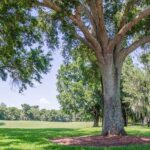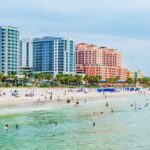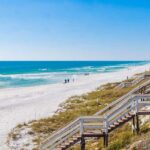Florida may be famous for its endless summer vibe, but the state actually experiences distinct seasonal changes, just not in the traditional four-season way. Due to its subtropical and tropical climates, Florida’s weather is best defined by temperature shifts, humidity levels, and rainfall patterns rather than snow or falling leaves.
The northern parts of Florida are not too different from the northern states it borders, except that the temperature ranges are not as great. South Florida is more tropical and has even less of a temperature range throughout the year.
Summer (June – November): Hot, Wet, Stormy, and Hurricane season
Florida summers are long and basically extends into the fall season. It is hot, humid and typically brings afternoon thunderstorms.
The high humidity makes the air feels thick making outdoor activities exhausting without shade or AC. And with the high temperatures reaching into the mid-90s, the humidity can make it feel over 100°F (38°C+).
Nearly every afternoon, brief but intense storms roll in, often with heavy rain, lightning, and gusty winds. These usually pass quickly, leaving muggy conditions behind.
Florida is the most hurricane-prone state in the U.S. and brings the highest risk of tropical storms, flooding, and power outages.
Fall Season (October – November): Still Summer weather but less severe.
In Central and North Florida we typically start to feel a fall-like coolness and break from high humidity sometime toward the end of October.
Some people do not realize it because Florida is abundant in trees that stay green all year long, but we do have deciduous trees in Central and Northern Florida that turn colors and loose their leaves this time of year. South Florida does not really have much of a Fall.
Winter / Spring Season in Florida
While some may not call our winters real winters, perhaps they are more like a winter/spring combination. This time of year is also known as Florida’s dry season.
Floridians at this time of year look forward to turning off their air conditioners and opening the windows from around November thru April/May and enjoying the dryer, cooler air and cool breezes.
We still have many hotter days during this time (especially in South Florida) and many colder days (especially in Northern Florida). The expression, “April showers bring May flowers” was not written for Florida! April is one of the driest months of the year.
Winter is felt more in the northern part of the state during the months of December thru February. Central Florida and South Florida are warmer and dryer and tend to feel like spring throughout the winter months.
Some of our other “Florida” seasons:
Hurricane Season
June 1st – November 30th
Turtle Nesting Season
Most active May 1st – October 31st
Manatee Season
Officially October 15th thru March 31st but Manatees stay in some areas all year long
Snowbird Season
Northerners start flocking to Florida typically from October/November thru April/May
Love Bug Season
Varies across the state, most often late April to early May and again in August/September, while in south Florida, there may be another smaller flight in December.
Spiny Lobster Season
Regular season is August 6 through March 31
Tree Planting Season
Generally December through February but can vary from the Southern regions to the Panhandle.











